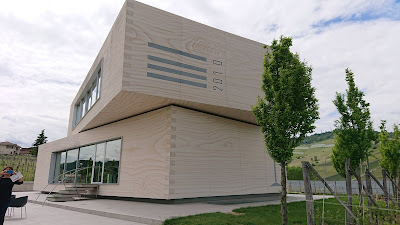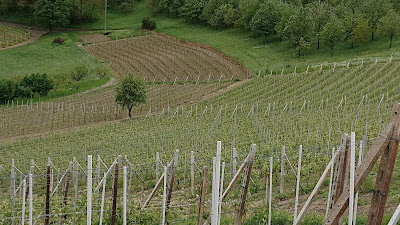Ever been to Barolo? Cute but surprisingly small and insignificant bearing in mind the global reputation of Barolo wine. St. Emilion, even Montalcino are more substantial. Perhaps to counter that the Comune of Barolo has taken initiatives to put Barolo on he map in a more substantive way that just being at the epicentre of the great vineyards of the area.
 |
| D'Agata with friend (Ian: "Don't worry, she's married.") |
Barolo's long establsihed festival is called Collisioni and has featured some big name pop musicians over the years as well as having a more cultured, more bookish side. Think Glastonbury plus Hay on Wye.
D'Agata has supplied a food and drink element to Collisioni but has also initiated two wine events, 'Indigena' for wine professionals and BING, Best Italian Native Grapes for anyone who might be interested and many were.
It was to BING in particular that we were drawn although we did attend a more academic tasting as well (see previous post).
BING promised 300 bottles and indeed there may well have been that amount. There were plenty of native grapes of course but not all were Cinderellas. Inevitably, Nebbiolo had a number of exhibitors for example.
Our first stop was chez Grosjean, prominent producer from Aosta with Fumin, Torrette (which is mostly Petit Rouge with perhaps Mayolet and Cornalin in the blend), Pinot Noir etc.
By coincidence we had flown in to Torino the night before and enjoyed a bottle of Grosjean Petite Arvine at the fantastically plutocratic 'Del Cambio' restaurant. We hasten to add we only arrived there following a couple of less than positive experiences attempting to find a table at other Torinese restaurants.
Ristorante del Cambio is a historic place (1757) where Cavour was a regular and everyone should try to eat there once in a lifetime if they can or else just go in and take a peek. The staff there are very nice and amenable.
It is not overpriced by any means and standards are high. We had to try the speciality of the house: Finanziera - a strange combination dating back to 1450 of meaty outcuts (including cockscombs) in an intense reduction sauce. Considered 'cucina povera,'. Oh well, we once ate donkey in Cremona.
Next, an opportunity to clear up a confusione. We had been aware of Maculan's Vespaiolo (funny the sign should say Vespaiola) for many years. It's a nice grape making full bodied dry wines or else sweet ones. Maculan are the great producers. We had a senior moment however when we suddenly recalled a red wine of the same name. We asked the Maculan people about this but they had no idea what we were talking about. Then it dawned on us we were thinking about Vespolina. Not a million miles from Vespaiolo but perhaps knowledge of BING varieties is not universal even in Itlay, even in wine circles, thus providing further proof of the need for BING.
Arvesiniadu is described in Native Wine Grapes of Italy as 'a true Sardinian native that is now almost extinct.' It was brought back to life by a group of local growers collaborating with experts at the Consorzio Interprovinciale della Frutticoltura di Cagliari and the University of Sassari. They go straight into the Slotovino Roll Call of Honour.
Ian also mentioned that there was a completely unknown variety called Muristellu to be found here. He was right in that we had never heard of Muristellu but Muristellu may be a biotype of Bovale Sardo.There is another Bovale though - Bovale Grande - again unrelated. What is often referred to just as Bovale is not anything to do with the Spanish Bobal as many supposed. Both Bovales have been linked to various grapes including Graciano, Cagnulari, Carignano, Monastrell and others, No wonder Native Wine Grapes of Italy says more research is called for.
Whatever the reality may be, Quartomoro's MRS (shorthand for Muristellu) is another amazingly beautiful wine. We were so taken by MRS Muristellu and ARV Arvesiniadu that we begged the Quartomoro people to let us buy a bottle of each. Readers, they wanted to give them to us. We won't describe the argument that followed but suffice it to say that an agreement was reached and we were able to take these two wines home with us.
 |
| downstairs signpost |
The folowing are photos of Albarossa bottles not on show at BING but in a showcase in the lecture hall of the Castello di Barolo where the tutored tastings took place. Someone believes in Albarossa for sure;
In the show too, Albarossa figured quite widely considering it's origins. It is a 1938 crossing of Chatus and Barbera. Giovanno Dalmasso thought he was making a cross between Nebbiolo and Barbera but his Nebbiolo was Nebbiolo di Dronero aka. Chatus.
We should have investigated Brachettone because it is not just Brachetto with longer grapes. Growers like to call it Birbet because there is a well known brand of Salami called Brachettone. D'Agata tells us Brachettone is more rustic and wild than Brachetto with greater salinity and acidity. It just shows that you can never do everything at a big show like BING.
For example, this bottle of Incrocio Bruni 54. We know about Incrocios from Luigi Manzoni and Rebo Rigotti but not so far about Bruno Bruni. His was a particularly amusing story which nonetheless had a happy ending. The 54 refers to the number of attempts he made to cross Sauvignon Blanc with Verdicchio. On the face of it not the most difficult thing to do but apparently it was and 54 was the number of attempts poor Bruni made to achieve this. When he finally succeeded he lost all interest in the matter and had nothing more to do with it.
The happy ending is that the wine as realized by the interesting Terracruda estate is quite wonderful and proved a crowd pleaser at a tasting with some friends.
Terracruda is between Pesaro and Urbino and pactices low-impact methods with everything being done by hand.
Their other claim to fame was a Garofanata in purezza. Garofanata is actually an offspring of Trebbiano Toscano but never mind. It has a personality all of its own and a very pleasant one at that.
 |
| Gilli |
Malvasia di Castelnuovo Don Bosco seems to be a DOC. The grape is Malvasia di Schierano.
 |
| Malvasia di Castelnuovo Don Bosco in the glass. |
 |
| Dlica in the glass |
Cascina Gilli's Dlica is from the same varieties but sweeter - the grapes having been dried.
 |
| Ca del Prete |
MALVè
La bacca aromatica di un antico vitigno del Monferrato, coltivata e vinificata rispettando il disciplinare comunitario di VINO BIOLOGICO, regala questa sorprendente bollicina rosa extra dry.
Un vino moderno nato dalle antiche tradizioni contadine,
We're not sure it was Extra Dry, more amabile really.
Moscato Rosa sounded vaguely familiar and we found we had included this as one of the many varieties recovered by Emilio Bulfon. He of the Slotovino Roll Call of Honour of course. The Malvasia Rosa at BING was made by Marco Donati.
 |
| not your usual car park view |
There are also a number of natural 'Amphitheatres'. Impressive.
 |
| Gianni Arnaudo is the architect (2010) |
 |
| L'Astemia Pentita means the Penitent Teetotaller. |
 |
| What is that on the ceiling? |
 |
| Stand in the right spot and you'll see. |
 |
| Risotto al Barolo - delicious |
with wines from E.85 - E.3,900. The choice is yours.
Congratulations to all concerned with this opening edition of BING.It was as instructive as it was fun. We are sure of its continuing success and recommend it to all who can make their way there next year.



































No comments:
Post a Comment